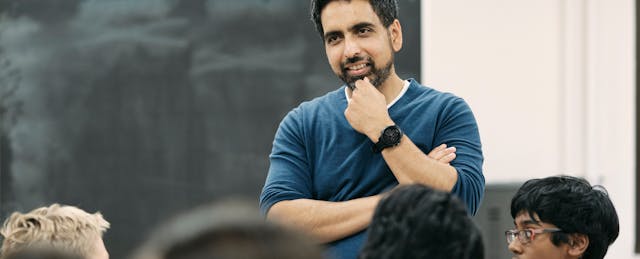This op-ed is part of a series of reflections on the past decade in education technology. In 2008, Sal Khan founded Khan Academy, the online education nonprofit where is now CEO, and in 2014 he founded the Khan Lab School.
A lot has changed over the last decade, but it’s interesting to look at things that haven’t changed too. I made three assumptions back in 2010 that still hold sway today.
Although I didn’t know it a decade ago, I now understand these assumptions are enduring. They inform my day-to-day work as well as the important learnings I’ll take forward for years to come.
1. Teachers are the unwavering center of schooling and we should continue to learn from them every day.
At the beginning of the decade, we worked with a handful of early adopters. They were the outliers, those willing to open up their classrooms to try new things. Some of the teachers taught in traditionally high-performing suburban schools (like the Los Altos School District in Los Altos, Calif.) and others worked in underserved communities where many of their students would be the first in their families to go to college (for example, at Eastside College Preparatory School in East Palo Alto and Oakland Unity High School in Oakland, Calif.). Most were near our offices in Silicon Valley so that we could learn from them firsthand.
I think we all knew, even back then, that technology could one day deliver on the long-held dream of helping teachers to differentiate instruction for every student. At the same time, we knew that technology was nowhere near a silver bullet. I was humbled by these early teachers’ feedback and the learnings they shared. I recognize today that they were important forerunners of the wave to come.
Fast forward to 2019. We’re working with teachers across the country now. They’re using technology as an integral part of their instruction and personalizing instruction for a classroom of students with diverse learning needs.
Equally important, they’re never using “technology for technology’s sake.” I, like many teachers, share a deep belief that we should decide how to best meet the needs of students before turning to technology. Not the other way around. Technology can be pen and paper, or adaptive software, or whatever is most helpful for the learning task at hand.
2. Students need exposure to rigorous grade-level curriculum and they need to work at their learning edge.
Back in 2010, my experience tutoring told me that students’ struggles had nothing to do with “innate ability” or subject matter difficulty. Instead, they struggled largely due to knowledge gaps and weak foundations that had been accumulated over time. We needed to meet students where they were, diagnose their gaps, and then allow them to progress at a speed right for them.
I talked about mastery learning a lot back then. By enabling progress through a mastery-based system, we would help students build confidence and challenge them in the most personalized way. In 2015, a major report from the research nonprofit RAND found that personalized learning works, confirming many of our hopes. It also pointed to challenges implementing mastery in the classroom—challenges we’re eagerly making progress on to this day.
I continue to talk about mastery now because I believe more strongly than ever in its power to tailor education for every student. The philosophical core of Khan Academy is mastery learning.
Yet a tension exists today between the notion of assigning grade-level work and providing a highly personalized, mastery-based learning experience for every student. I’d posit that it’s a false choice, and here’s why: We can have both.
If the standards that are in a student’s zone of proximal development are rigorously addressed, we can deliver personalized lessons and practice. We can evaluate a student’s progress and adjust plans as needed. The key constraint in the classroom is time, in the school day and over the course of the school year. While we haven’t completely cracked that nut yet, the data is promising. We’re learning that as little as one class period per week of personalized, mastery-based learning can have a substantial impact on student achievement in math. It’s a small investment that will pay dividends over time.
3. Our public schools are an abiding institution that is making important progress despite many challenges
There is good news about public schools. Take, for example, the nation’s progress on wiring classrooms. A survey of schools and libraries done by the FCC in 2010 found that 80% reported that broadband services did not “fully meet their current needs.” Today, 99% of U.S. classrooms have high-speed internet access. A recent report by the nonprofit Education SuperHighway declared that “the classroom connectivity gap has been closed.”
That’s astounding progress across urban, suburban and, importantly, rural areas throughout the country. We are now largely past the hard work of putting the infrastructure in place to enable access to digital learning tools.
This isn’t to say we’ve fixed all the infrastructural or the many other challenges in public education. But schools have made significant progress and today teachers, students and administrators are poised to make new advances in the decade to come.
And Khan Academy will hopefully be right there with them. The past decade has been an exciting time of learning and doing. But as far as we’re concerned, things are just getting started.


